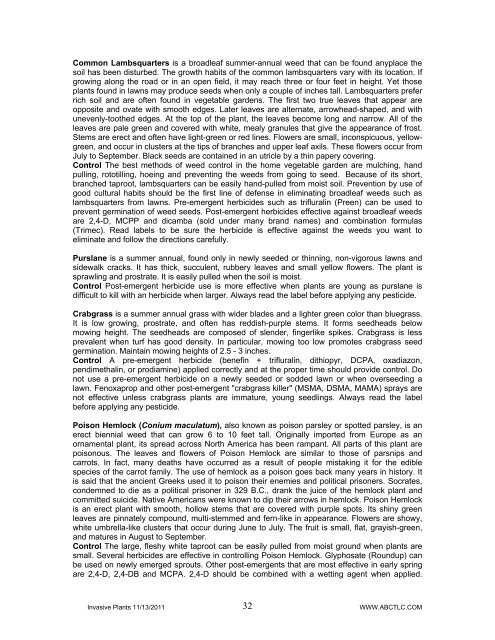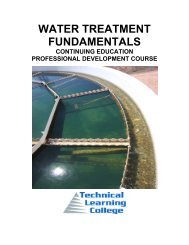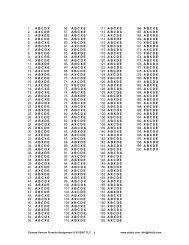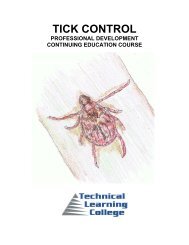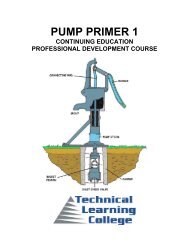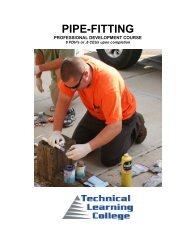INVASIVE PLANTS - Technical Learning College
INVASIVE PLANTS - Technical Learning College
INVASIVE PLANTS - Technical Learning College
You also want an ePaper? Increase the reach of your titles
YUMPU automatically turns print PDFs into web optimized ePapers that Google loves.
Common Lambsquarters is a broadleaf summer-annual weed that can be found anyplace the<br />
soil has been disturbed. The growth habits of the common lambsquarters vary with its location. If<br />
growing along the road or in an open field, it may reach three or four feet in height. Yet those<br />
plants found in lawns may produce seeds when only a couple of inches tall. Lambsquarters prefer<br />
rich soil and are often found in vegetable gardens. The first two true leaves that appear are<br />
opposite and ovate with smooth edges. Later leaves are alternate, arrowhead-shaped, and with<br />
unevenly-toothed edges. At the top of the plant, the leaves become long and narrow. All of the<br />
leaves are pale green and covered with white, mealy granules that give the appearance of frost.<br />
Stems are erect and often have light-green or red lines. Flowers are small, inconspicuous, yellowgreen,<br />
and occur in clusters at the tips of branches and upper leaf axils. These flowers occur from<br />
July to September. Black seeds are contained in an utricle by a thin papery covering.<br />
Control The best methods of weed control in the home vegetable garden are mulching, hand<br />
pulling, rototilling, hoeing and preventing the weeds from going to seed. Because of its short,<br />
branched taproot, lambsquarters can be easily hand-pulled from moist soil. Prevention by use of<br />
good cultural habits should be the first line of defense in eliminating broadleaf weeds such as<br />
lambsquarters from lawns. Pre-emergent herbicides such as trifluralin (Preen) can be used to<br />
prevent germination of weed seeds. Post-emergent herbicides effective against broadleaf weeds<br />
are 2,4-D, MCPP and dicamba (sold under many brand names) and combination formulas<br />
(Trimec). Read labels to be sure the herbicide is effective against the weeds you want to<br />
eliminate and follow the directions carefully.<br />
Purslane is a summer annual, found only in newly seeded or thinning, non-vigorous lawns and<br />
sidewalk cracks. It has thick, succulent, rubbery leaves and small yellow flowers. The plant is<br />
sprawling and prostrate. It is easily pulled when the soil is moist.<br />
Control Post-emergent herbicide use is more effective when plants are young as purslane is<br />
difficult to kill with an herbicide when larger. Always read the label before applying any pesticide.<br />
Crabgrass is a summer annual grass with wider blades and a lighter green color than bluegrass.<br />
It is low growing, prostrate, and often has reddish-purple stems. It forms seedheads below<br />
mowing height. The seedheads are composed of slender, fingerlike spikes. Crabgrass is less<br />
prevalent when turf has good density. In particular, mowing too low promotes crabgrass seed<br />
germination. Maintain mowing heights of 2.5 - 3 inches.<br />
Control A pre-emergent herbicide (benefin + trifluralin, dithiopyr, DCPA, oxadiazon,<br />
pendimethalin, or prodiamine) applied correctly and at the proper time should provide control. Do<br />
not use a pre-emergent herbicide on a newly seeded or sodded lawn or when overseeding a<br />
lawn. Fenoxaprop and other post-emergent "crabgrass killer" (MSMA, DSMA, MAMA) sprays are<br />
not effective unless crabgrass plants are immature, young seedlings. Always read the label<br />
before applying any pesticide.<br />
Poison Hemlock (Conium maculatum), also known as poison parsley or spotted parsley, is an<br />
erect biennial weed that can grow 6 to 10 feet tall. Originally imported from Europe as an<br />
ornamental plant, its spread across North America has been rampant. All parts of this plant are<br />
poisonous. The leaves and flowers of Poison Hemlock are similar to those of parsnips and<br />
carrots. In fact, many deaths have occurred as a result of people mistaking it for the edible<br />
species of the carrot family. The use of hemlock as a poison goes back many years in history. It<br />
is said that the ancient Greeks used it to poison their enemies and political prisoners. Socrates,<br />
condemned to die as a political prisoner in 329 B.C., drank the juice of the hemlock plant and<br />
committed suicide. Native Americans were known to dip their arrows in hemlock. Poison Hemlock<br />
is an erect plant with smooth, hollow stems that are covered with purple spots. Its shiny green<br />
leaves are pinnately compound, multi-stemmed and fern-like in appearance. Flowers are showy,<br />
white umbrella-like clusters that occur during June to July. The fruit is small, flat, grayish-green,<br />
and matures in August to September.<br />
Control The large, fleshy white taproot can be easily pulled from moist ground when plants are<br />
small. Several herbicides are effective in controlling Poison Hemlock. Glyphosate (Roundup) can<br />
be used on newly emerged sprouts. Other post-emergents that are most effective in early spring<br />
are 2,4-D, 2,4-DB and MCPA. 2,4-D should be combined with a wetting agent when applied.<br />
Invasive Plants 11/13/2011 32<br />
WWW.ABCTLC.COM


